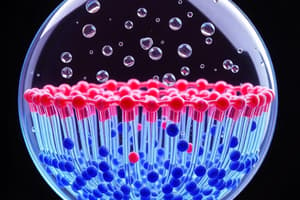Podcast
Questions and Answers
The molecule's function is to __________.
The molecule's function is to __________.
provide structural support to the lipid bilayer
The molecule's function is to __________.
The molecule's function is to __________.
send out localized cellular signals
Which of the following statements about the molecule shown is FALSE?
Which of the following statements about the molecule shown is FALSE?
- It has the same composition in all types of cell membranes. (correct)
- It plays a role in cell signaling.
- It contains both hydrophilic and hydrophobic regions.
- It is responsible for membrane fluidity.
The following molecule is a/an __________.
The following molecule is a/an __________.
Which of the following is NOT a class of lipid?
Which of the following is NOT a class of lipid?
Ruptured biological membranes are 'self-sealing' due to all of the following factors EXCEPT for __________.
Ruptured biological membranes are 'self-sealing' due to all of the following factors EXCEPT for __________.
Which of the following populations of fatty acids would most likely be a solid at room temperature?
Which of the following populations of fatty acids would most likely be a solid at room temperature?
All of the following are functions of lipids EXCEPT __________.
All of the following are functions of lipids EXCEPT __________.
The extracellular side of a transmembrane helix of an integral membrane protein does NOT contain __________.
The extracellular side of a transmembrane helix of an integral membrane protein does NOT contain __________.
Where in an animal cell would this molecule most likely be located?
Where in an animal cell would this molecule most likely be located?
Bacteria that thrive in cooler growth temperatures compensate by __________ as compared to bacteria growing at warmer temperatures.
Bacteria that thrive in cooler growth temperatures compensate by __________ as compared to bacteria growing at warmer temperatures.
The molecule's function is to __________.
The molecule's function is to __________.
What is the name of the lipid that yields glycerol, a 16:3 cis(Δ9,11,13) fatty acid, an omega-3,6 fatty acid (12:2), phosphoric acid, and a monosaccharide in a 1:1:1:1:1 molar ratio?
What is the name of the lipid that yields glycerol, a 16:3 cis(Δ9,11,13) fatty acid, an omega-3,6 fatty acid (12:2), phosphoric acid, and a monosaccharide in a 1:1:1:1:1 molar ratio?
Which of the following is NOT a membrane lipid?
Which of the following is NOT a membrane lipid?
Which of the following populations of fatty acids will have the highest melting temperature?
Which of the following populations of fatty acids will have the highest melting temperature?
The polar head group of a sterol is __________.
The polar head group of a sterol is __________.
The symbolic notation for the fatty acid structure shown is __________.
The symbolic notation for the fatty acid structure shown is __________.
The molecule's function is to __________.
The molecule's function is to __________.
Glycerol is not a lipid because it is __________.
Glycerol is not a lipid because it is __________.
If the only protein that remains associated with the membrane is protein A, then one can conclude that __________.
If the only protein that remains associated with the membrane is protein A, then one can conclude that __________.
This molecule is a component of __________.
This molecule is a component of __________.
Increasing the membrane composition of cholesterol will likely __________.
Increasing the membrane composition of cholesterol will likely __________.
Flashcards are hidden until you start studying
Study Notes
Membrane Lipids and Functions
- Sterols: Known for a steroid nucleus and a single polar head group, they provide structural support to the lipid bilayer.
- Eicosanoids: Includes prostaglandins, which are local signaling molecules derived from polyunsaturated fatty acids. They play a role in pain, inflammation, and local housekeeping.
- Fatty Acids: Monounsaturated fatty acids contain one double bond and are generally cis; saturated fatty acids with long chains tend to be solid at room temperature due to stronger intermolecular interactions.
- Triacylglycerols (TAGs): Composed of three acyl chains attached to a glycerol backbone, these lipids are used for energy storage.
Types of Membrane Components
- Phospholipids and Sphingolipids: Essential for membrane fluidity and strength, phospholipids have a glycerol backbone, while sphingolipids contain an amine group.
- Glycoproteins and Glycolipids: These molecules feature carbohydrates (monosaccharides/polysaccharides) attached to proteins or lipids, important for cell recognition and signaling.
Membrane Composition and Fluidity
- Ruptured Membranes: Self-sealing properties stem from hydrophobic interactions among lipids; covalent interactions do not contribute to this property.
- Temperature Effects: Bacteria in colder environments incorporate more unsaturated fatty acids to maintain membrane fluidity, while saturated fatty acids are more stable at higher temperatures.
Membrane Proteins
- Peripheral vs. Integral Proteins: Peripheral proteins are loosely associated and can be removed by changes in pH or ionic strength, while integral proteins span the membrane and are removed by detergents.
- Glycosylation: Occurs on the extracellular side of integral proteins, aiding in cell recognition and interactions.
Lipid Classification and Characteristics
- Non-Lipid Components: Glycerol is not classified as a lipid since it lacks a hydrophobic tail; other listed components fit within the lipid category.
- Cholesterol's Role: Increasing cholesterol content tends to decrease membrane fluidity due to its rigid structure, which restricts the movement of phospholipids.
Fatty Acid Notation
- Symbolic Notation: For fatty acids, the notation like "18:1 (cis Δ9)" indicates 18 carbons, one double bond, and its location, defining its structure and form.
Key Points on Cellular Signaling
- Steroids: Characterized by a steroid nucleus, they serve to transmit global signals across the body and are more hydrophilic than sterols.
- Eicosanoids vs. Steroids: While both are signaling molecules, eicosanoids act locally, while steroids send systemic signals.
Membrane Liquid Crystals
- Fluid Mosaic Model: Membranes are described as fluid due to the movement of lipids and proteins; this model explains how diverse molecules interact within the bilayer.
Studying That Suits You
Use AI to generate personalized quizzes and flashcards to suit your learning preferences.



